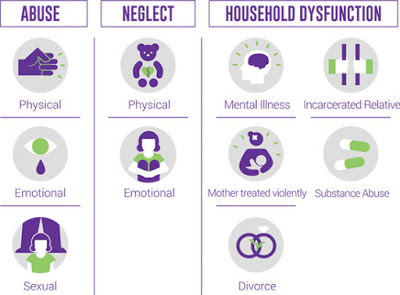Childhood experiences were studied in depth by the CDC-Kaiser Adverse Childhood Experiences Study, The 10 ACEs the researchers measured were :
— Physical, sexual and verbal abuse
— Physical and emotional neglect
— A family member who is depressed or diagnosed with other mental illness
— A family member who isaddicted to alcohol or another substance
— A family member who is in prison
— Witnessing a mother being abused
— Losing a parent to separation, divorce or other reason
These events were found to be the most impacting on a child’s development, and the most harmful to their future well-being.
Of course, there are many other types of childhood trauma — such as witnessing a sibling being abused, losing a parent, witnessing violence outside the home, witnessing a father being abused by a mother, being bullied by a classmate or teacher – but only 10 types were measured. They provide a useful marker for the severity of trauma experienced, and from that we can extrapolate that other types of trauma likely have a similar impact.
Kids who have had these kinds of stressors face challenges in school, life and ultimately, the state of their health. They are often walking through life with toxic stress. Toxic stress, unlike manageable stress, refers to the long-term changes in brain architecture and organ systems that develop after extreme, prolonged and repeated stress goes untreated. Exposure to ACEs may put children at higher risk for learning difficulties, emotional problems, developmental issues and long-term health problems.
The #ChildrenCanThive campaign seeks to help families incorporate self-care practices that are known to reduce stress hormones, like regular exercise, good nutrition, healthy sleep, mindfulness, and therapy when needed. Join the #ChildrenCanThrive campaign to learn more, and be part of a growing movement to address childhood adversity.

